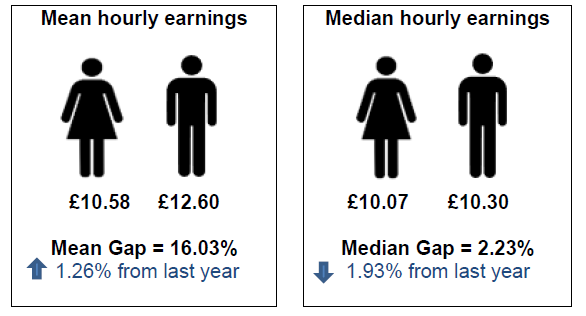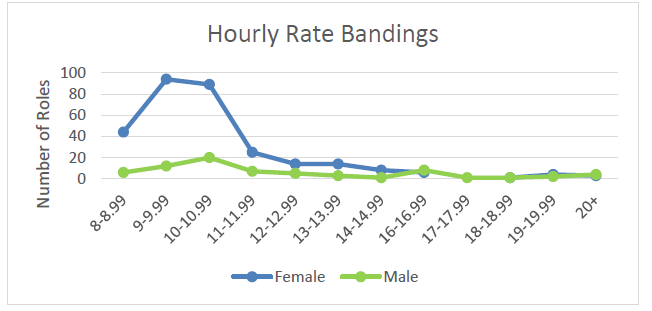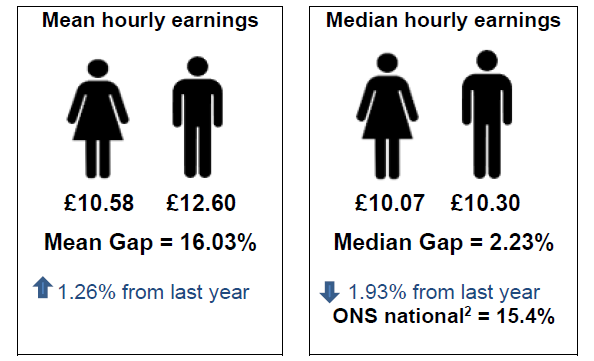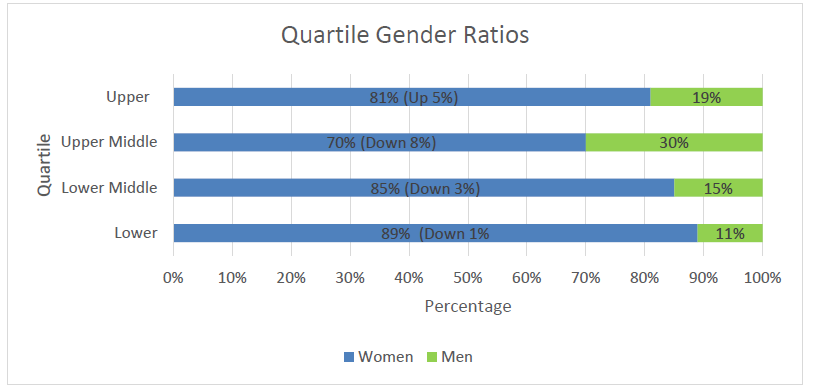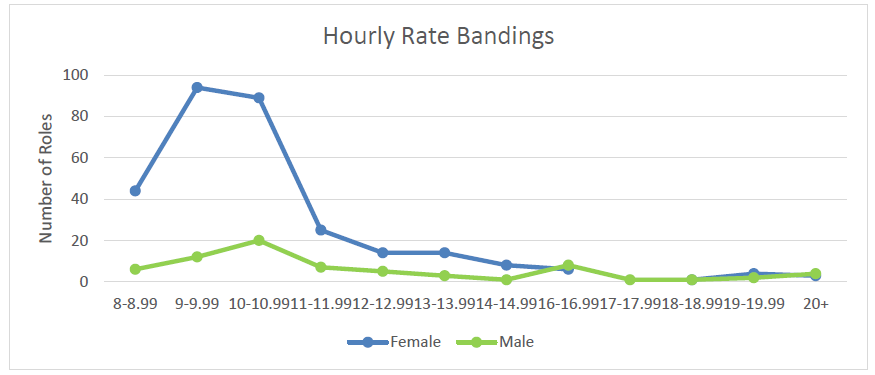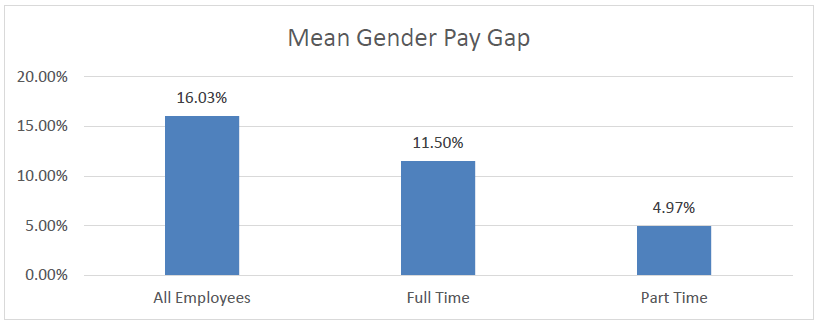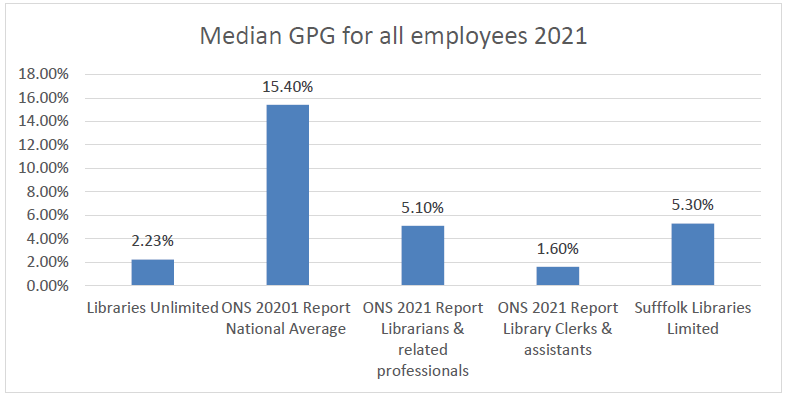Libraries Unlimited Gender Pay Gap as at April 2021
- Executive Summary
On 5th April 2021 Libraries Unlimited had 372 relevant roles with 302 filled by women (81%) and 70 filled by men (19%). As Libraries Unlimited does not have a bonus scheme, the percentage difference between men and women’s bonuses was zero.
Libraries Unlimited’s Gender Pay Gap is largely a result of our workforce being predominantly women (which we know from our colleagues is a trend across the library sector) but that being more pronounced in the lower quartiles. There are more women at all levels of the organisation, but significantly fewer men in the lower and lower middle quartiles (26% across both compared to 19% in the upper quartile alone). The below chart shows that the number of men and women on higher hourly rates are very similar, but there are a lot more women than men on the lower hourly rates
Libraries Unlimited’s GPG is also affected by a high number of employees working part time who are nationally more likely to be paid a lower hourly median pay than full time workers(1). It is argued that this is because traditionally part-time roles are less senior and therefore are paid less, with a legacy perspective that lower paid roles can be performed part time more easily; and that women have been more likely to take part time roles to fit around caring responsibilities. 63% of our workforce are part-time women, which has decreased by 4% since 2020, but only 9% are part time men which has also decreased by 2%.
Another factor which effects our GPG is our use of relief contracts. 21% of Libraries Unlimited’s roles are relief of which 91% are women and 96% are paid within the lower quartile. As these roles are flexible, they can be more easily managed around caring responsibilities and therefore may be more attractive to women who continue to take on a significantly higher share of the caring. If we exclude relief roles our mean GPG reduces by 1.92%.
Our median GPG is 2.23% which has decreased by 1.93% since last year which highlights a greater level of overall equality and is significantly less than the ONS national average of 15.4%. Compared to other Library Services, our GPG is similar or better.
As an organisation, we are disappointed that we continue to have a Gender Pay Gap, and it is something that we remain committed to continually working on, focussing on creating greater diversity in our staff across the whole organisation to better represent the communities we work in. We set out a number of actions we proposed to take in October 2021 when reporting on our April 2020 figures. Work against these actions is well under way, but will not have been able to affect the April 2021 figures given that they were already in the past. In particular, we continue to work on encouraging more men into frontline roles, women into senior roles in all areas of the organisation especially traditionally male dominated sectors, and men to utilise flexible working and family friendly policies such as Shared Parental Leave. However, it is also important to recognise that these actions will be part of a large cultural shift that is required, both within the organisation and as a wider society, so we recognise that this is a direction of travel that we are very committed to, rather than actions that will automatically result in change within the following year.
- Introduction
As an organisation with more than 250 employees, we are legally required to comply with the Equality Act 2010 (Specific Duties and Public Authorities) Regulations 2017 and publish Gender Pay Gap reporting information on an annual basis.
The Gender Pay Gap (GPG) is defined as the difference between the mean and median hourly rate of pay that men and women receive, regardless of their role. It is not just a measure of the difference in pay between men and women for doing the same job.
The mean pay gap is the difference between average hourly earnings of men and women.
The median pay gap is the difference between the mid points in the ranges of hourly earnings of men and women. It takes all salaries in the sample, lines them up in order from lowest to highest, and picks the middle-most salary.
- Our Gender Pay Gap results
On 5th April 2021 Libraries Unlimited had 459 roles. However, 87 roles have been excluded as per the government guidance as they received either ‘no pay’ in the relevant pay period (1st – 30th April) or were on reduced pay due to maternity or paternity leave, unpaid leave or unpaid sickness. Therefore, Libraries Unlimited had 372 roles with 302 filled by women (81%) and 70 filled by men (19%).
This means men were paid either 2.23% (median) or 16.03% (mean) more than women.
In looking at our full time (3) employees only, this gap widens with men paid 9.47% (median) more than women. However, this gender pay gap for full time employees has decreased compared to last year by 2.84%.
Libraries Unlimited does not pay bonuses to any staff; therefore, the further three statutory calculations of the mean bonus Gender Pay Gap, the median bonus Gender Pay Gap and the proportion of men and women receiving a bonus payment are not applicable.
- Analysis
Libraries Unlimited’s Gender Pay Gap continues to largely be a result of our workforce being predominantly women (which we know from our colleagues is a trend across the library sector) but that being more pronounced in the lower quartiles. There are more women at all levels of the organisation, but are still significantly fewer men in the lower and lower middle quartiles (26% across both) and most in the upper quartile (19%). Overall, the percentage of roles filled by men has increased by 1.8% compared to 2020.
The percentage of men has increased in all of the quartiles apart from the upper quartile which has decreased by 5%. However, the upper middle quartile has increased by 8% which continues to affect the pay gap.
In addition to calculating the statistics that are legally required, Libraries Unlimited has done some further analysis to aid understanding of its Gender Pay Gap.
The following graph shows that Libraries Unlimited has significantly more women than men on hourly rates between £8.00 – £14.99. The numbers of men and women from an hourly rate of £16.00 upwards is relatively even. In the upper quartile there are 7 roles with an hourly rate of £20+ and 57% of those are men, no change to last year. Of the top 3 highest hourly rate roles of the organisation, 2 of them are female. This indicates that our GPG is primarily caused by large proportions of women in lower hourly rate posts, rather than male dominance in senior roles.
It is believed that the reasons for female dominance in the lower paid posts are consistent with what has been found by the ONS, specifically a higher proportion of lower paid roles are performed part-time, as many of our roles are, and in particular the specific flexibility of relief contracts, which is commonly attractive to women as it is compatible with their personal circumstances, such as caring responsibilities which women are more likely to have than men.
4(a). Part time working
ONS report that around 6% of men work part time compared to around 18% of women (4). National statistics also show that part time workers (male and female) are paid a lower hourly median pay than full time workers (5). It is argued that this is because traditionally part-time roles are less senior and therefore are paid less, with a legacy perspective that lower paid roles can be performed part time more easily. Libraries Unlimited’s GPG is therefore slightly affected by the fact that 63% of the workforce are part-time women, but only 9% are part time men. Since 2020 the percentage of part time women in the organisation has decreased by 4% and men has also decreased by 2%.
The mean gender pay gap for full time employees is 11.5% which is a decrease of 2.86% from 2020. Including part time employees, our GPG increases to 16.03%, confirming that part time working does influence our GPG. Whilst there is a much smaller gender pay gap for part time employees (4.97%), the average part time women’s pay is much lower than that of their full-time colleagues, by around £3.71 per hour.
Our part time women’s pay gap which is a comparison of women’s part time average hourly rate to men’s full time average hourly rate is 35.87%. This means part time women within our organisation are paid 35.87% less than full time men. However, this has decreased by 2.12% since 2020, which is positive.
4(b). Age of staff
National Statistics(6) show that the GPG increases by around 9% for people over 40. However, this is not the case for Libraries Unlimited. Our mean GPG for over 40’s is less than our GPG for under 40’s, which is substantially different from 2020. In 2020 our mean GPG for under 40’s was 6.20% which has increased by over 10% in 2021. Our mean GPG for over 40’s has decreased since 2020 by 1.8%.
Although in 2021 there is only an increase of 1 male in the under 40 category the differences in rates of pay have substantially increased with more men falling in the upper quartile. In 2021 there are 13 roles with an hourly rate of between £10 – £24 whilst in 2020 there were only 7 roles. This has resulted in an increased GPG for under 40’s. When you include employees who are over 40, it reduces our overall mean GPG, suggesting that this year having an older workforce has not affected our GPG in the same way.
4(c). Relief contracts
Almost a quarter (21%) of Libraries Unlimited’s roles are relief roles, which has decreased by 8% since 2020 – we are aware that there were several resignations and retirements from the relief workforce, largely influenced by the pandemic. Of the relief roles 91% are women and a majority (96%, which has increased by 15% since 2020) are paid within the lower quartile.
It is important to note that this year 51% of relief roles were excluded from our GPG reporting as they received ‘no pay’ within the relevant period. This has substantially increased compared to 2020, where only 23% of relief roles were excluded. This exclusion of relief roles of which a majority are paid within the lower quartile will have decreased our GPG.
However, if we were to look at Libraries Unlimited’s fixed hours only roles, therefore exclude the relief roles, our mean Gender Pay Gap would be 14.11% which is a reduction by 1.92%. Therefore, this suggests that our GPG is still affected by the amount of relief roles we have. As these roles are flexible, they can be more easily managed around caring responsibilities and therefore may be more attractive to women, as set out above.
4(d). GPG across different teams
GPG across different teams
Support/office teams make up 8.9% of our roles – this includes the following small teams, all with a manager; Finance, IT, HR & Volunteering, Fundraising & Marketing,Premises, BIPC, Evolve, and Executive. Because they are such small teams, 91% of our support roles fall in the Upper Middle and Upper quartiles, compared to 46% for our Service Delivery roles. Men make up 56% of the support roles, with 83% falling in the Upper quartile, an increase of 10% compared to 2020 (although that is not actually many people given the small number involved).
The GPG for our support teams has considerably decreased since 2020 from 24.12% to 8.07% (median) and from 15.18% to 7.84% (mean). This is due to an increase of 4% of women in support roles, with 1 more women in the upper middle and 2 more in the upper quartile compared to 2020. The GPG for support teams is still considerably higher than our service delivery teams GPG though, which is 1.18% (median) and from 6.94% (mean).
The reason the GPG may be higher for the support roles is because they are largely specialisms which tend to be dominated by men, such as IT, Finance and Executive. As
per ONS findings women hold only 20% of IT roles, 47% of Finance roles and 35% Chief Exec & Senior roles.(7) This is representative within our organisation with women holding none of the IT roles, and only 33% of Finance roles. They do hold 50% of Chief Exec & Executive roles however.
Our service delivery team have a lower GPG which indicates that we are providing better progression for women through our service delivery roles, which we also have examples of anecdotally as well. With the support teams, there is less opportunity for progression because they are smaller teams with less routes for people to progress into.
- External comparisons
As Gender Pay Gaps are affected by gender ratios of support staff, part time ratios and age demographics we need to be careful when making external comparisons.
Our median GPG is 2.23% which highlights a greater level of overall equality and is significantly less than the ONS national average of 15.4%. Compared to other Library Services such as Suffolk’s Libraries Limited, our median is 3.07% less(8). This suggests that within a similar sector our GPG is favourable. Our GPG is also similar to “Library clerks and Assistants” (as reported in the ONS figures) which a makes up most of our workforce.
- Reducing the Gender Pay Gap
As an organisation, we are disappointed that we continue to have a Gender Pay Gap, We also recognise that these results will also have been affected by the significantly fewer relief staff working during this period, as explained above. Addressing our GPG is something that we remain committed to continually working on, focussing on creating greater diversity in our staff across the whole organisation to better represent the communities we work in. In particular, we continue to work on encouraging more men into frontline roles, women into senior roles in all areas of the organisation especially traditionally male-dominated sectors, and men to utilise flexible working and family friendly policies such as Shared Parental Leave.
The reasons behind our Gender Pay Gap as set out in this report have not substantially changed since our last report on the 2020 figures, except that age does not appear to be a factor this time. In the report on the 2020 figures which was published in October 2021, we set out key actions that we planned to take to address the figures. Given the delayed reporting for the 2020 figures due to COVID, April 2021 on which these figures are based was already passed by the time these actions were set, so it was impossible for any changes made since October 2021 to have had an impact on these historic figures.
Our actions set out in the report were;
- Reviewing our current recruitment practices to ensure that we are targeting less well represented groups such as men within the lower paid roles and within our Service Delivery teams, and women in the senior support roles. This will include:• Working to embed diversity, inclusion, and accessibility into all stages of our recruitment process.
• Undertaking a review of job descriptions/adverts and the language within them to highlight and change any unintentional gendered language.
• Recognising, and challenging unconscious bias throughout the selection process. - Continuing to build more substantial posts to be attractive to a wider range of people through things like combining roles as vacancies come up (including roles across different locations).
- Promoting the flexibility of our relief roles to all members of the community who may be attracted by that flexibility, such as students, self-employed individuals with their own businesses or part time workers who want additional income and in particular men so that our relief roles are more representative of the communities we support.
- Promoting workplace flexibility for both men and women in roles where possible, such as hybrid working (home and office based), job sharing or compressed hours. Also encouraging men to work flexibly so that it is not seen as only a female benefit.
- Promoting our family friendly policies to ensure that women can progress if they have caring responsibilities and to encourage men to take on the primary carer role where they want to do that. Also embed a culture where our family friendly policies are not only offered but are normalised into smarter working practices. As an organisation we provide Maternity Pay that is more generous than the statutory minimum, like 63.5% of other organisations (36.5% do not offer enhanced maternity pay).(9) We also provide enhanced Shared Parental Leave pay, which only a quarter of organisations offer.(10) Our Shared Parental Leave pay is enhanced at the same rate as our Maternity Pay which supports a government initiative identified to address GPG.(11)
- Providing apprenticeships and training opportunities for career development and maintaining our level of internal progression, enabling employees to realise their
full potential. Also, more Level 2 and Level 3 apprenticeships may result in more diversity in the lower paid roles as they may be more attractive to a wider range of people who will then get a good start in their career. - Ensuring all employees undertake the E-learning Equality, Diversity and Inclusion training, and consider how to embed this in their working practices so that everyone feels welcomed and support when appointed so they are committed and likely to stay.
- Continuing to record recruitment statistics to analyse gender ratios of applicants through recruitment stages, so that we can gain a better understanding of where ratio disparity occurs.
Work on these actions is well under way. Key things we have been working on already include:• Developing a shorter and more accessible Customer Service Assistant role description for advertising, and introducing guide questions to help applicants focus on the key points of the person specification;
• Introducing an accessible “About your Interview” guide which will go out to all candidates in advance to support them to feel prepared;
• Introduced hybrid working as default for those teams where this is possible;
• Carried out a survey of our relief staff to understand their motivations for having relief contracts to act as a baseline to consider how to target different groups;
• Listed the Equality & Diversity training on the list of training that needs to be done annually, and introduced processes to monitor that this is done in all teams. It is also positive to see that there has been a slight increase in the number of men in the lower two quartiles and an increase in women in the upper quartile – although these are only slight increases, this is something that we can hopefully learn from and build on in the future. There has also been a very slight decrease in the part time roles within the organisation as well, which although small, is consistent with trying to build more substantial posts where that is possible. Given the timing of the review period (1st-30th April), these figures also unfortunately do not include the very successful Library Digital Assistants programme we have had over the last year, funded by the government’s KickStart scheme. These are entry-level roles, and 11 of the 12 posts have been filled by men, a number of whom have now moved into permanent roles with us. We have already been speaking to these Library Digital Assistants to understand what attracted them to the role, to see what learning we can take from that for our wider recruitment.In addition, we will also add two further actions that we will take on over the coming year: - Ensure that our Gender Pay Gap reporting for each April is done by July that year to allow for the embedding of any actions well in advance of the next reporting period;
- As part of our strategy, we will be working towards becoming a Real Living Wage employer – this will have an impact on those on the lower hourly rates, such as relief staff who were paid 59p per hour below the Real Living Wage in April 2021. However, we will still have to consider the impact of this on the differentiation between roles that is there to reflect the different levels of responsibility/technical knowledge that is expected, but becoming a Real Living Wage employer therefore may have an positive impact on our GPG.
However, it is also important to recognise that all of these actions will be part of a large cultural shift that is required, both within the organisation and as a wider society, so we recognise that this is a direction of travel that we are very committed to, rather than actions that will automatically result in change within the following year.
Our full results are:
Quartile Gender Ratios
| Quartile | Female | Male |
|---|---|---|
| Lower | 89% | 11% |
| Lower Middle | 85% | 15% |
| Upper Middle | 70% | 30% |
| Upper | 81% | 19% |
Hourly Rate Bandings
| Female | Male | |
|---|---|---|
| £8-£8.99 | 44 | 6 |
| £9-£9.99 | 94 | 12 |
| £10-£10.99 | 89 | 20 |
| £11-£11.99 | 25 | 7 |
| £12-£12.99 | 14 | 5 |
| £13-£13.99 | 14 | 3 |
| £14-£14.99 | 8 | 1 |
| £15-£15.99 | N/A | N/A |
| £16-£16.99 | 6 | 8 |
| £17-£17.99 | N/A | 1 |
| £18-£18.99 | 1 | 1 |
| £19-£19.99 | 4 | 2 |
| £20+ | 3 | 4 |
Libraries Unlimited Part Time
| Female | Male | |
|---|---|---|
| Part time | 63% | 9% |
| Full time | 18% | 10% |
National Average Part Time Working
| Female | Male | |
|---|---|---|
| Part time | 18% | 6% |
| Full time | 32% | 44% |
Mean Gender Pay Gap Part Time Working
| All employees | 16.03% |
| Full time employees | 11.50% |
| Part time employees | 4.97% |
Median GPG for all employees – comparison
| Libraries Unlimited | 2.23% |
| ONS 2020 Report National Average | 15.40% |
| ONS 2020 Report Librarians & related professional | 5.10% |
| ONS 2020 Report Library clerks & assistants | 1.60% |
| Suffolk Libraries Limited | 5.30% |
(1) https://www.ons.gov.uk/employmentandlabourmarket/peopleinwork/earningsandworkinghours/bulletins/genderpaygapintheuk/2020
(2) Office for National Statistics – Gender Pay Gap in the UK; 2021.
(3) Full time is defined as more than 30 hours per week as per Office for National Statistics.
(4) Based on Office of National Statistics – full time, part time and temporary workers figures EMP01 Sep – Nov 2021.
(5) https://www.ons.gov.uk/employmentandlabourmarket/peopleinwork/earningsandworkinghours/bulletins/genderpaygapintheuk/2020
(6) https://www.ons.gov.uk/employmentandlabourmarket/peopleinwork/earningsandworkinghours/bulletins/genderpaygapintheuk/2021
(7) https://www.ons.gov.uk/employmentandlabourmarket/peopleinwork/earningsandworkinghours/bulletins/genderpaygapintheuk/2020
(8) Gender Pay Gap (GPG) at Suffolk Libraries IPS Ltd https://www.suffolklibraries.co.uk/about/legal-information/gender-pay-gap
(9) https://www.xperthr.co.uk/survey-analysis/maternity-leave-and-pay-xperthr-survey-2021/165964/?keywords=maternity+pay+survey
(10) https://www.xperthr.co.uk/survey-analysis/paternity-and-shared-parental-leave-and-pay-xperthr-survey-2021/165965/
(11) https://gender-pay-gap.service.gov.uk/actions-to-close-the-gap/promising-actions
Previous Year

